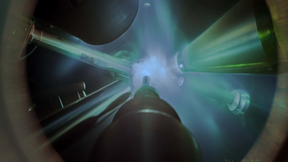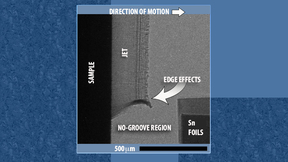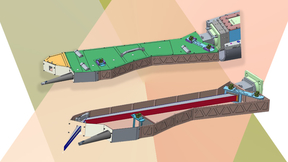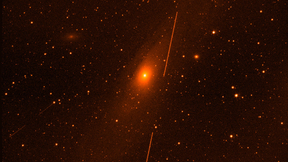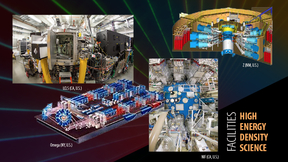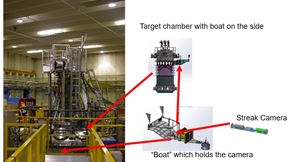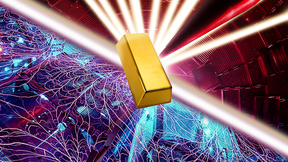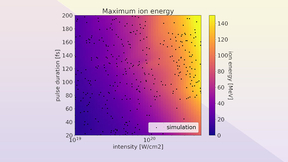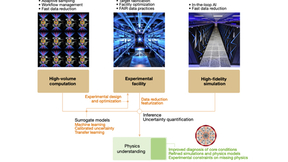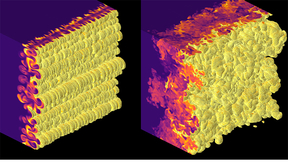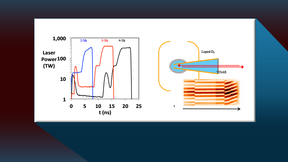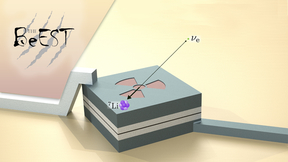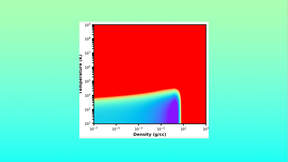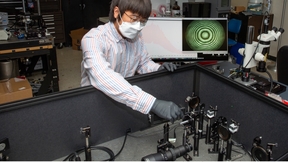Back
Physics
National Ignition Facility experiment puts researchers at threshold of fusion ignition
On Aug. 8, 2021, an experiment at Lawrence Livermore National Laboratory’s (LLNL’s) National Ignition Facility (NIF) made a significant step toward ignition, achieving a yield of more than 1.3 megajoules (MJ). This advancement puts researchers at the threshold of fusion ignition, an important goal of the NIF, and opens access to a new experimental regime. The experiment…
Researchers focus on how tantalum behaves at high pressure and temperature
Lawrence Livermore National Laboratory (LLNL) researchers have explored high-pressure behavior of shock-compressed tantalum at the Omega Laser Facility at the University of Rochester’s Laboratory for Laser Energetics (LLE). The work showed tantalum did not follow the predicted phase changes at high pressure and instead maintained the body-centered cubic (BCC) phase until…
Scientists use radiography to understand the evolution of liquid and solid microjets
Lawrence Livermore National Laboratory (LLNL) scientists have experimentally tested the predictions of a 2020 study that computationally investigated the effect of melting on shock driven metal microjets. That earlier work predicted that melting the base material does not necessarily lead to a substantial increase in jet mass. The LLNL team confirmed the predictions of…
Scientists create a novel instrument to probe thermal states of extreme matter on Earth
Scientists at Lawrence Livermore National Laboratory (LLNL) have collaborated with Princeton Plasma Physics Laboratory (PPPL) to design a novel X-ray crystal spectrometer to provide high-resolution measurements of a challenging feature of high energy density (HED) matter produced by National Ignition Facility (NIF) experiments. The work is featured in a paper in the Review…
LLNL/Tyvak space telescope goes into orbit
Thousands of images of Earth and space have been taken by a compact space imaging payload developed by Lawrence Livermore National Laboratory (LLNL) researchers and its collaborator Tyvak Nano-Satellite Systems. Known as GEOStare2, the payload has two space telescopes that together have taken more than 4,500 pictures for space domain awareness, astronomy and Earth…
Research highlights techniques for studying materials under extreme conditions
The properties of materials under extreme conditions are of key interest to a number of fields, including planetary geophysics, materials science and inertial confinement fusion (ICF). In geophysics, the equation of state of planetary materials such as hydrogen and iron under ultrahigh pressure and density will provide a better understanding of their formation and interior…
The Materials Scientist Who Studies the Innards of Exoplanets
Federica Coppari uses the world’s most powerful laser to recreate the cores of distant worlds.
From NIF to Z: LLNL continues to collaborate with Sandia on technology transfer projects
Lawrence Livermore National Laboratory (LLNL) and Sandia National Laboratories continue to collaborate on diagnostic advancements on the nation’s premier high-energy density (HED) facilities. Mark Bowers, magnetic direct drive diagnostics manager at the National Ignition Facility (NIF), said current projects include providing NIF’s X-ray streak camera, neutron Time-of…
Smashing gold with finesse: Shockless compression experiments establish new pressure scales
To test the Standard Model of particle physics, scientists often collide particles using gigantic underground rings. In a similar fashion, high-pressure physicists compress materials to ever greater pressures to further test the quantum theory of condensed matter and challenge predictions made using the most powerful computers. Pressures exceeding 1 million atmospheres are…
Scientists use simulations to examine the performance of materials in NIF experiments
Scientists have examined the performance of pure boron, boron carbide, high-density carbon and boron nitride ablators — the material that surrounds a fusion fuel and couples with the laser or hohlraum radiation in an experiment — in the polar direct drive exploding pusher (PDXP) platform, which is used at the National Ignition Facility (NIF). The platform uses the polar…
Experiments validate the possibility of helium rain inside Jupiter and Saturn
Nearly 40 years ago, scientists first predicted the existence of helium rain inside planets composed primarily of hydrogen and helium, such as Jupiter and Saturn. However, achieving the experimental conditions necessary to validate this hypothesis hasn’t been possible — until now. In a paper published today by Nature, scientists reveal experimental evidence to support this…
Laser-driven ion acceleration with deep learning
While advances in machine learning over the past decade have made significant impacts in applications such as image classification, natural language processing and pattern recognition, scientific endeavors have only just begun to leverage this technology. This is most notable in processing large quantities of data from experiments. Research conducted at Lawrence Livermore…
The data-driven future of extreme physics
By applying modern machine learning and data science methods to “extreme” plasma physics, researchers can gain insight into our universe and find clues about creating a limitless amount of energy. In a recent perspective published in Nature, Lawrence Livermore National Laboratory (LLNL) scientists and international collaborators outline key challenges and future directions…
Scientists identify key trends in high-energy-density mixing layers
Imagine a bottle of salad dressing containing oil and vinegar. The oil has a lower density than vinegar, so it floats on the vinegar. The oil will not stay trapped under the vinegar if the bottle is flipped upside down. It will bubble up through the vinegar until a stable state is restored. This simple physical process is known as Rayleigh–Taylor instability, and it can be…
It’s only natural: Using environmental microbes to remove uranium from groundwater
Uranium contamination of soils and groundwater in the United States represents a significant health risk and will require multiple remediation approaches. Remediation strategies for uranium-contaminated sites have been the focus of research for decades due to the former production of nuclear materials across the United States. The U.S. Environmental Protection Agency (EPA)…
1D model helps clarify implosion performance at NIF
In inertial confinement fusion (ICF) experiments at the National Ignition Facility (NIF), a spherical shell of deuterium-tritium fuel is imploded in an attempt to reach the conditions needed for fusion, self-heating and eventual ignition. Since theory and simulations indicate that ignition efficacy in one-dimension (1D) improves with increasing imploded fuel convergence…
Sterile neutrinos may be portal to the dark side
“Sterile neutrinos” are theoretically predicted new particles that offer an intriguing possibility in the quest for understanding the dark matter in our universe. Unlike the known “active” neutrinos in the Standard Model (SM) of particle physics, these sterile neutrinos do not interact with normal matter as they move through space, making them very difficult to detect. A…
Scientists reject restrictive heat flux models using directly driven gold spheres
A team of scientists have conducted an analysis of directly driven gold sphere experiments to test heat transport models used in inertial confinement fusion (ICF) and high energy density (HED) modeling. It was found that overly restricting the heat flux caused disagreement with measurement. However, simulations with a reduced nonlocal heat transport model quantitatively…
Researchers construct an EOS delivery paradigm for beryllium
Beryllium is a lightweight, low-density material used in a wide range of applications that require stability at high temperatures and pressures. Because of beryllium’s favorable traits, it has been considered as a potential capsule material for inertial confinement fusion (ICF) applications. Hydrodynamic simulations of ICF are frequently used to model the capsule behavior…
Lab team’s new interferometric instrument improves refractive index measurements at high pressure
In a paper recently published by Scientific Reports, a team of scientists from Lawrence Livermore National Laboratory (LLNL) describes a high-precision interferometer system, newly developed to measure the pressure dependence of the refractive index and its dispersion in diamond anvil cells (DACs). “Accurately measuring the index of a compressed sample in DACs is a…



